It looks like you're using an Ad Blocker.
Please white-list or disable AboveTopSecret.com in your ad-blocking tool.
Thank you.
Some features of ATS will be disabled while you continue to use an ad-blocker.
share:
What's wrong with picture?

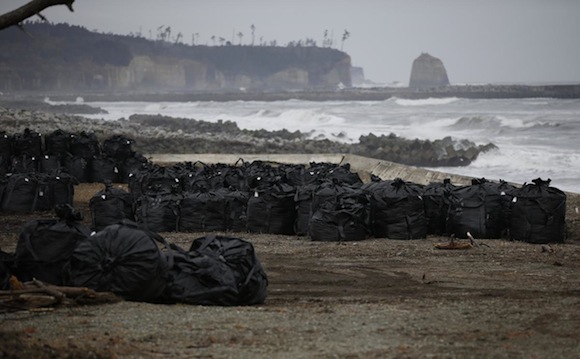
Big black plastic bags containing irradiated material from the decontamination operation are dumped at a seaside devastated by the March 11, 2011 earthquake and tsunami in Tomioka town, Feb. 22. (Toru Hanai/Reuters)
Egad! The whole cleanup effort is just another example of the Japanese government's form-over-function "gambarimasu" response to every crisis that comes their way — showing the public that they are pouring cash and countless man hours into taking action, even if that action delivers absolutely no positive outcome - like that stupid-from-the-start ice wall.
Smoke and mirrors.
To date, over 5.5 million bags have been filled.
Let me guess…more technonolgy that has to yet be invented.
Which brings up the point of how long do these super-dooper TEPCO RAD-BAGS last when filled with radioactive debris?
When and how was the testing done to determine a "shelf-life" of the bag?
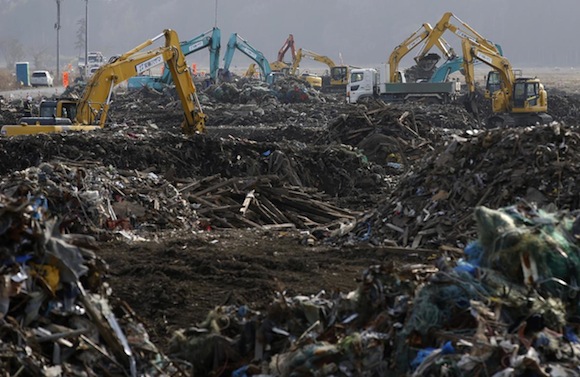
Workers operate heavy machinery to remove debris at an area devastated by the March 11, 2011 earthquake and tsunami in Namie town, Fukushima prefecture on Feb 24. (Toru Hanai/Reuters)
No wonder it's taking so long to remove debris. Look at the size of that dump truck! Can we say, "milking the deal?"
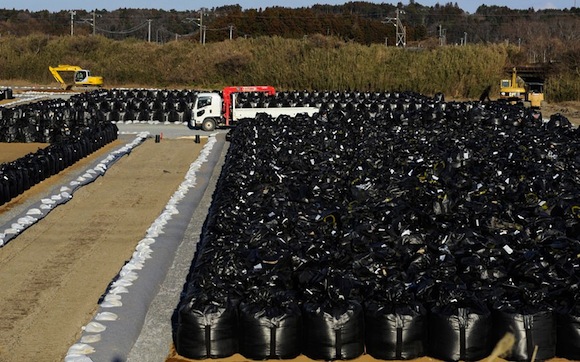
Large black plastic bags containing contaminated soil and leaves are stocked in a temporary storage facility in the town of Naraha, Fukushima prefecture (Picture: EPA/FRANCK ROBICHON)

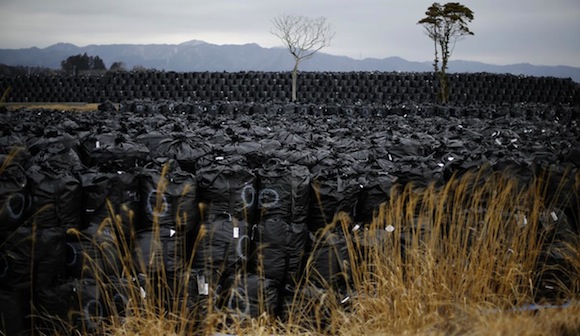
Big black plastic bags containing radiated material from the decontamination operation are dumped at a temporary storage site in Tomioka town. (Toru Hanai/Reuters)
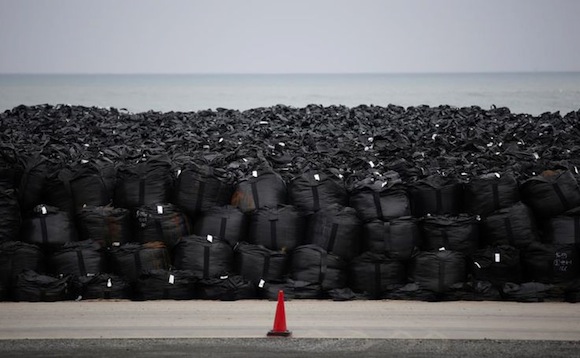
Mar 13, 2015 - The fruits of the laborers’ efforts are stacked in those giant sacks—5.5 million of them and counting. They are spread out across Fukushima province, along roadsides, in parking lots and backyards. (courtesy Reuters)
They are tagged and bar-coded so authorities know what’s inside and how radioactive it is – and when the bags might start to wear out.
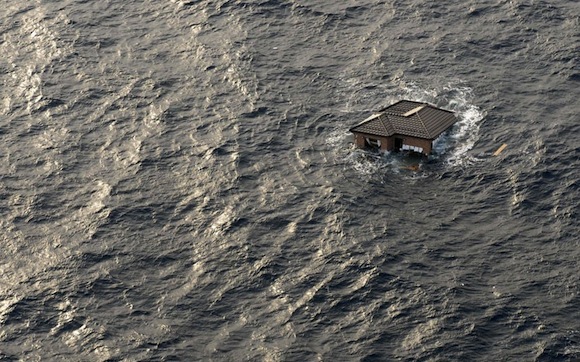
13 March 2011: A home is seen adrift in the Pacific Ocean, two days after the earthquake and tsunami (Picture: REUTERS/U.S. Navy photo by Mass Communication Specialist 3rd Class Dylan McCord)
"We want the name of this house-builder, as we have a very special project for him." signed, Noah
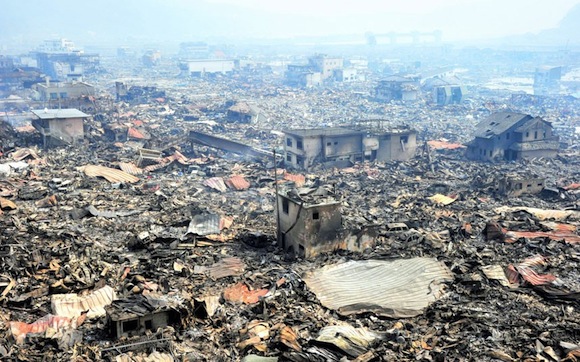
14 March 2011: An aerial view shows the scale of the tsunami damage in Otsuchi, Iwate prefecture (Picture: EPA/ASAHI SHIMBUN)
Lest we forget…
Peace Love Light
tfw Liberty & Equality or Revolution


Big black plastic bags containing irradiated material from the decontamination operation are dumped at a seaside devastated by the March 11, 2011 earthquake and tsunami in Tomioka town, Feb. 22. (Toru Hanai/Reuters)
Egad! The whole cleanup effort is just another example of the Japanese government's form-over-function "gambarimasu" response to every crisis that comes their way — showing the public that they are pouring cash and countless man hours into taking action, even if that action delivers absolutely no positive outcome - like that stupid-from-the-start ice wall.
Smoke and mirrors.
The Environment Ministry wants to wrap up the cleaning brigades by 2017, but where to put all the material they’ve collected remains a vexing challenge. Authorities recently started construction on a massive specialized landfill in a pink zone just outside the Fukushima Dai-ichi plant. When complete, it is expected to hold between 16 million and 22 million bags of debris – enough to fill about 15 baseball stadiums.
Even if all those details could be worked out immediately, there is still the question of just how to get millions of bags of radioactive debris to the landfill. A 10-ton truck can only carry seven bags at a time. At that rate, transport could take decades.
To date, over 5.5 million bags have been filled.
Material might have to be put into fresh bags if they start to break down before they can be moved."
Let me guess…more technonolgy that has to yet be invented.
Which brings up the point of how long do these super-dooper TEPCO RAD-BAGS last when filled with radioactive debris?
When and how was the testing done to determine a "shelf-life" of the bag?

Workers operate heavy machinery to remove debris at an area devastated by the March 11, 2011 earthquake and tsunami in Namie town, Fukushima prefecture on Feb 24. (Toru Hanai/Reuters)
No wonder it's taking so long to remove debris. Look at the size of that dump truck! Can we say, "milking the deal?"

Large black plastic bags containing contaminated soil and leaves are stocked in a temporary storage facility in the town of Naraha, Fukushima prefecture (Picture: EPA/FRANCK ROBICHON)


Big black plastic bags containing radiated material from the decontamination operation are dumped at a temporary storage site in Tomioka town. (Toru Hanai/Reuters)

Mar 13, 2015 - The fruits of the laborers’ efforts are stacked in those giant sacks—5.5 million of them and counting. They are spread out across Fukushima province, along roadsides, in parking lots and backyards. (courtesy Reuters)
They are tagged and bar-coded so authorities know what’s inside and how radioactive it is – and when the bags might start to wear out.

13 March 2011: A home is seen adrift in the Pacific Ocean, two days after the earthquake and tsunami (Picture: REUTERS/U.S. Navy photo by Mass Communication Specialist 3rd Class Dylan McCord)
"We want the name of this house-builder, as we have a very special project for him." signed, Noah

14 March 2011: An aerial view shows the scale of the tsunami damage in Otsuchi, Iwate prefecture (Picture: EPA/ASAHI SHIMBUN)
Lest we forget…
Peace Love Light
tfw Liberty & Equality or Revolution
edit on 6/4/2015 by thorfourwinds because: lynx
edit on 6/4/2015 by thorfourwinds because: (no reason
given)
edit on 6/4/2015 by thorfourwinds because: (no reason given)
“War is peace.
Freedom is slavery.
Ignorance is strength.”
Freedom is slavery.
Ignorance is strength.”
edit on 6/4/2015 by thorfourwinds because: ttyyppooss
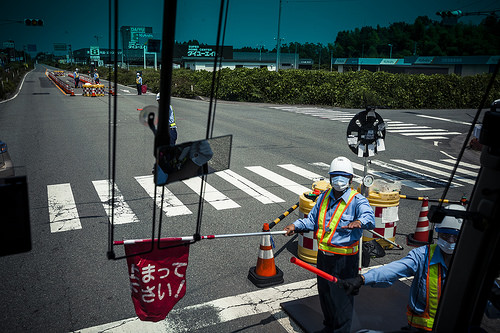
(courtesy Green Cross)
Report: Over 30 million permanently affected by Fukushima radiation
11 March 2015
Green Cross International (NGO founded by Mikhail Gorbachev, former President of the Soviet Union), Mar 11, 2015: 32 million people in Japan still exposed to radiation from the Fukushima nuclear disaster… according to the 2015 Fukushima Report now available from Green Cross…
[They are] at potential risk from both long and short-term consequences…
Japan is expected to see increased cancer risk…
Chernobyl and the Fukushima Daiichi nuclear power plant disasters were categorized as level 7 events – defined as a major release of radioactive material, with widespread effects, requiring planned and extended countermeasures…
“However, the number of people affected by radiation in Japan has tripled compared to Chernobyl,” said Nathalie Gysi of Green Cross Switzerland… water leakage at the Fukushima Daiichi power plant remains a problem four years after…
There continue to be… rising doubts over the safety of seafood, such as radioactivity levels in tuna and other fish…
The Fukushima Report was prepared under the direction of Dr. Jonathan M. Samet, MD, Professor at the USC School of Medicine and chair of Preventive Medicine… using the same measurement standards as a similar 2012 study on Chernobyl…
The lives of approximately 42 million people have been permanently affected by radioactive contamination caused by… Chernobyl and Fukushima Daiichi…
Continued exposure to low-level radiation, entering the human body on a daily basis through food intake, is of particular consequence.
The 2015 Fukushima Report is available for download in English at www.greencross.ch...
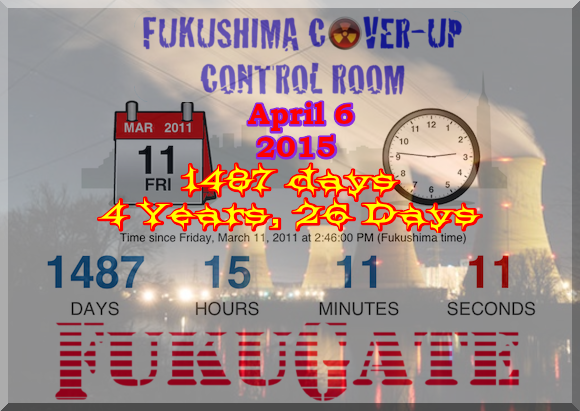
“It was a bright cold day in April, and the clocks were striking thirteen.”

PRESS RELEASES
For information only - not an official document
Increase in Cancer Unlikely following Fukushima Exposure – says UN Report
VIENNA, 2 April 2014
(UN Information Service) - Cancer levels are likely to remain stable in the wake of the 2011 Fukushima-Daiichi nuclear power accident, according to a new UN report released today.
The report is titled Levels and effects of radiation exposure due to the nuclear accident after the 2011 great east-Japan earthquake and tsunami, by the United Nations Scientific Committee on the Effects of Atomic Radiation (UNSCEAR).
It finds that no discernible changes in future cancer rates and hereditary diseases are expected due to exposure to radiation as a result of the Fukushima nuclear accident; and, that no increases in the rates of birth defects are expected.
Nevertheless, it notes a theoretical possibility that the risk of thyroid cancer among the group of children most exposed to radiation could increase and concludes that the situation needs to be followed closely and further assessed in the future.
Thyroid cancer is a rare disease among young children, and their normal risk is very low.
If you say so.

Another one bites the dust as the band plays on.
www.smithsonianmag.com...
“So far, urchin die-offs have been observed and documented at four sites along the 200 miles between Point Conception and Santa Catalina Island, and at a fifth site off Baja California. Most are purple urchins, Raimondi says, and there are reports of mass mortalities. Some scientists think another species, the green sea urchin, which lives along the north coast, could be next.
“There are particular signs that point to this being a wasting event, the way the animals are dying,” [University of California, Santa Cruz ecology professor Peter] Raimondi says. The most common kinds of California urchins – purple, red, and white – are losing their spines, and the leading edge of spine loss is often discolored pink or white.”
www.smithsonianmag.com...
“So far, urchin die-offs have been observed and documented at four sites along the 200 miles between Point Conception and Santa Catalina Island, and at a fifth site off Baja California. Most are purple urchins, Raimondi says, and there are reports of mass mortalities. Some scientists think another species, the green sea urchin, which lives along the north coast, could be next.
“There are particular signs that point to this being a wasting event, the way the animals are dying,” [University of California, Santa Cruz ecology professor Peter] Raimondi says. The most common kinds of California urchins – purple, red, and white – are losing their spines, and the leading edge of spine loss is often discolored pink or white.”
The following is from the Diary. I can't read Japanese and haven't found an english translation but I trust Iori and this much of a jump is the most
in a short time since 2011. However, since they are doing muon testing on Unit 2 it could be somekind of reaction associated with that.
fukushima-diary.com... /
A thermometer of Reactor 2 indicates a rapid increase of temperature / From 20℃ to 70℃ within 6 hours
The thermometer is located in dry well of primary containment vessel. It has been indicating 21℃ until 5AM of 4/3/2015, however it jumped up to 70℃ by 11AM of the same day. It kept on increasing and reached 88℃ by 5PM of 4/5/2015.
At 11AM of 4/7/2015, it is still 84℃.
fukushima-diary.com... /
A thermometer of Reactor 2 indicates a rapid increase of temperature / From 20℃ to 70℃ within 6 hours
The thermometer is located in dry well of primary containment vessel. It has been indicating 21℃ until 5AM of 4/3/2015, however it jumped up to 70℃ by 11AM of the same day. It kept on increasing and reached 88℃ by 5PM of 4/5/2015.
At 11AM of 4/7/2015, it is still 84℃.
Just so people understand that the US could care less about it's people and only cares to keep industry humming along, the following article from
SimplyInfo explains the latest. Not only has the US stopped monitoring for radiation off the coast, and taken radiation monitoring sites offline in
the US when they show high levels of rads, they won't test food from Japan as well. Our country is so sick I am ashamed to say that I once believed
in it.
www.fukuleaks.org...
US Lax Regulations On Japan Food Imports Raise More Concerns As TPP Close To A Vote
A recent Japanese food mislabeling scandal in Taiwan showed the differing levels of oversight between countries when it comes to food imports. The US has refused to do any meaningful testing and has clung to an unusually high limit before any product would be taken off the market if it was even tested at all........
The US FDA is supposed to conduct radionuclide testing on the US food supply on a quarterly basis. That data has not been published since 2006. The FDA responded to an inquiry about the years of missing market basket data in 2014 where they claimed it would be published in early 2015 yet that data is still missing. FDA’s official response to risks from imported foods was that other countries are doing testing, Japan’s own testing (this is seriously limited) and their own market basket radiation testing that hasn’t been published since 2006. So in essence the FDA has done nothing to actually screen imported foods for radiation in any way.
www.fukuleaks.org...
US Lax Regulations On Japan Food Imports Raise More Concerns As TPP Close To A Vote
A recent Japanese food mislabeling scandal in Taiwan showed the differing levels of oversight between countries when it comes to food imports. The US has refused to do any meaningful testing and has clung to an unusually high limit before any product would be taken off the market if it was even tested at all........
The US FDA is supposed to conduct radionuclide testing on the US food supply on a quarterly basis. That data has not been published since 2006. The FDA responded to an inquiry about the years of missing market basket data in 2014 where they claimed it would be published in early 2015 yet that data is still missing. FDA’s official response to risks from imported foods was that other countries are doing testing, Japan’s own testing (this is seriously limited) and their own market basket radiation testing that hasn’t been published since 2006. So in essence the FDA has done nothing to actually screen imported foods for radiation in any way.
At the same time that the US refuses to monitor for radiation in the ocean, air and in food, independent testing is showing high levels of rads in
numerous places in the US. Check Amarillo TX, Albuquerque NM, Phoenix AZ and Bakersfield CA. These places are all spiking between 500 and 1000 CPM
with some spikes over 1000 and off the chart.
www.fukuleaks.org...
Other places like Lincoln NE and Tucson AZ are spiking between 300 to 500 with Ft Smith AR starting to spike that high in recent weeks. However, it appears that California and the Southwest are the main rad zones with diminishing returns the further north and east you go.
Wouldnt you want your government to be on top of this situation. Unfortunately our government is too busy rebuilding it's nuke pile, supplying arms to the world's warlords and defending local police after they murder innocent people. You know, important stuff like that.
www.fukuleaks.org...
Other places like Lincoln NE and Tucson AZ are spiking between 300 to 500 with Ft Smith AR starting to spike that high in recent weeks. However, it appears that California and the Southwest are the main rad zones with diminishing returns the further north and east you go.
Wouldnt you want your government to be on top of this situation. Unfortunately our government is too busy rebuilding it's nuke pile, supplying arms to the world's warlords and defending local police after they murder innocent people. You know, important stuff like that.
More evidence that a nuclear explosion underground happened at Units 3 and 4. From ENE this AM is a report from US scientists tracking the rad plume
after the explosions. The bottomline is that a hydrogen explosion not only doesn't fit any of the physical evidence on site, it wouldn't produce the
level of rads that ended up on the other side of the pond. And as a result of these detections our ever vigilant government did the only logical
thing, they shut down the monitoring sites;
enenews.com... ay-matter-life-death-videos
“there are very high count rates at these detectors, which is similar to what you’d expect in an atmospheric detonation. On the other hand, the part I didn’t tell you was the amount of xenon we saw was consistent with a one megaton atmospheric detonation — we obviously wouldn’t expect to see that high. But it was a huge amount.”
fukushimaupdate.com...
And from Fukushima Update we have an even more incredulous story. TEPCO has figured out what to do with the contaminated water they wanted to dump in the ocean. They now say they are going to store it underground. So it appears that the groundwater that is also contaminated will be pumped out of the ground so it can be....stored in the ground?
enenews.com... ay-matter-life-death-videos
“there are very high count rates at these detectors, which is similar to what you’d expect in an atmospheric detonation. On the other hand, the part I didn’t tell you was the amount of xenon we saw was consistent with a one megaton atmospheric detonation — we obviously wouldn’t expect to see that high. But it was a huge amount.”
fukushimaupdate.com...
And from Fukushima Update we have an even more incredulous story. TEPCO has figured out what to do with the contaminated water they wanted to dump in the ocean. They now say they are going to store it underground. So it appears that the groundwater that is also contaminated will be pumped out of the ground so it can be....stored in the ground?
edit on 9-4-2015 by zworld because: (no reason given)
Okay folks, here we go!!!
www.japantimes.co.jp...
Three methods proposed for removing melted fuel from Fukushima No. 1 reactors
JIJI
APR 10, 2015
ARTICLE HISTORY
PRINT SHARE
FUKUSHIMA – The Nuclear Damage Compensation and Decommissioning Facilitation Corp. on Thursday proposed three methods for retrieving highly radioactive nuclear fuel debris in three crippled reactors at Tokyo Electric Power Co.’s disaster-stricken Fukushima No. 1 nuclear power plant.
The proposals, presented at a meeting of officials from Tepco, the central government and municipalities in Fukushima Prefecture, will be reflected in a decommissioning road map that the government and Tepco are set to release around May.
The three reactors underwent core meltdowns in March 2011, leaving melted nuclear fuel debris on the floor of their containment vessels. The decommissioning aid body hopes to establish concrete procedures by the first half of fiscal 2018.
One of the three proposed methods removes the debris in a submerged condition, with a containment vessel filled with water to shield against radiation and prevent the spread of radioactive materials during the retrieval process.
More at the link....
www.japantimes.co.jp...
Three methods proposed for removing melted fuel from Fukushima No. 1 reactors
JIJI
APR 10, 2015
ARTICLE HISTORY
PRINT SHARE
FUKUSHIMA – The Nuclear Damage Compensation and Decommissioning Facilitation Corp. on Thursday proposed three methods for retrieving highly radioactive nuclear fuel debris in three crippled reactors at Tokyo Electric Power Co.’s disaster-stricken Fukushima No. 1 nuclear power plant.
The proposals, presented at a meeting of officials from Tepco, the central government and municipalities in Fukushima Prefecture, will be reflected in a decommissioning road map that the government and Tepco are set to release around May.
The three reactors underwent core meltdowns in March 2011, leaving melted nuclear fuel debris on the floor of their containment vessels. The decommissioning aid body hopes to establish concrete procedures by the first half of fiscal 2018.
One of the three proposed methods removes the debris in a submerged condition, with a containment vessel filled with water to shield against radiation and prevent the spread of radioactive materials during the retrieval process.
More at the link....
a reply to: fakedirt
Total fubar. Like the idea to freeze the perimeter of an area that is being heated from radioactive materials. Fubar after fubar.
And the really crazy thing is the other idea they are working on is to evaporate the contaminated water and then deal with the solids. Considering all the water currently stored on site, all the contaminated water underground, and all the water that will move in under the plant in the future that will also be contamninated would be impossible to deal with like that.
The fact that they continue to grasp at straws dealing with the single worst environmental disaster weve faced is down right scary.
Total fubar. Like the idea to freeze the perimeter of an area that is being heated from radioactive materials. Fubar after fubar.
And the really crazy thing is the other idea they are working on is to evaporate the contaminated water and then deal with the solids. Considering all the water currently stored on site, all the contaminated water underground, and all the water that will move in under the plant in the future that will also be contamninated would be impossible to deal with like that.
The fact that they continue to grasp at straws dealing with the single worst environmental disaster weve faced is down right scary.
And the robot missions continue!!!
rt.com...
The operator of the Fukushima nuclear plant has sent a transforming robot to conduct an unprecedented mission inside the primary containment vessel of Reactor 1. This is the first time a robot has entered the damaged interior of the reactor.
The robot was to check the first floor of the containment vessel Friday, and will go on to explore the second half Monday.
The I-shaped device, about 9.5 centimeters high and 60 centimeters long, entered the vessel via a 10-centimeter diameter pipe, according to The Japan Times. After entering it assumed a shape similar to number 3 and was to measure temperature and radiation levels.
In October 2012, when a measuring device was put into the same vessel, the radiation peaked at 11 Sieverts per hour at most. One Sievert may cause illness if absorbed all at once, while 8 Sieverts may result in death.
More at the link....
rt.com...
The operator of the Fukushima nuclear plant has sent a transforming robot to conduct an unprecedented mission inside the primary containment vessel of Reactor 1. This is the first time a robot has entered the damaged interior of the reactor.
The robot was to check the first floor of the containment vessel Friday, and will go on to explore the second half Monday.
The I-shaped device, about 9.5 centimeters high and 60 centimeters long, entered the vessel via a 10-centimeter diameter pipe, according to The Japan Times. After entering it assumed a shape similar to number 3 and was to measure temperature and radiation levels.
In October 2012, when a measuring device was put into the same vessel, the radiation peaked at 11 Sieverts per hour at most. One Sievert may cause illness if absorbed all at once, while 8 Sieverts may result in death.
More at the link....
originally posted by: matadoor
And the robot missions continue!!!
rt.com...
The operator of the Fukushima nuclear plant has sent a transforming robot to conduct an unprecedented mission inside the primary containment vessel of Reactor 1. This is the first time a robot has entered the damaged interior of the reactor.
This is so funny. I was going to post a poll taking bets on how long that puppy would last and then I saw the following;
The first robot that entered Reactor 1 died in 5 hours
fukushima-diary.com...
It was around 9AM of 4/10/2015 when Tepco started the investigation. They managed to land the robot onto the ground floor of PCV, however it stopped around 2PM. It moved only for approx. 10m
edit on 11-4-2015 by zworld because: (no reason given)
originally posted by: matadoor
a reply to: zworld
"It's dead Jim".
Good one.
Also from the Diary this AM. Robots arent the only thing dying in the area. This sounds a bit ominous since it was a precursor to 3/11
160 dolphins went aground in Ibaraki / Same as 1 week before 311
Around 6AM of 4/10/2015, several local residents reported to the Maritime Safety Agency and fire house that approx. 160 dolphins went aground for a few km in Ibaraki.
It was the beach of Hokota city of Ibaraki prefecture. The dolphins were “Peponocephala electra [Wikipedia]”, 2〜3 m long.
Most of them were already dead. The living dolphins were sent back to the sea but they went aground by the next morning again.
The marine biologists are performing autopsy but the specific cause is not identified.
52 dolphins were also found aground in Ibaraki on 3/4/2011, when was 1 week before 311 took place. The beach was in South of Hokota city.
It was the same sort of dolphin as this time.
edit on 11-4-2015 by zworld because: (no reason given)
This is from 2013, but considering that there is a likelihood of another earthquake, I couldn't help but think that this is so accurate that it's
scary.
www.storyleak.com...
"They are lying through their teeth."
That's the only quote I'm posting, just watch the video.
www.storyleak.com...
"They are lying through their teeth."
That's the only quote I'm posting, just watch the video.
New earthquakes to hit Japan no later than 2017 says top scientist.
en.rocketnews24.com...
Look, I live on the East Coast, but if we end up evacuating the west coast, the US is going to not be a real fun place to live.
en.rocketnews24.com...
Look, I live on the East Coast, but if we end up evacuating the west coast, the US is going to not be a real fun place to live.
Temperature in 2 & 3 Spent Fuel Pool
They must of fixed something.
Beginning of April Unit 2 at 30 degrees Celsius, Unit 3 at 25 degrees:
www.tepco.co.jp...
Twelve days later SFP temps in Unit 2 and Unit 3 dropped significantly:
www.tepco.co.jp...
Great posts everyone!!!
- Purple Chive
They must of fixed something.
Beginning of April Unit 2 at 30 degrees Celsius, Unit 3 at 25 degrees:
www.tepco.co.jp...
Twelve days later SFP temps in Unit 2 and Unit 3 dropped significantly:
www.tepco.co.jp...
Great posts everyone!!!
- Purple Chive
originally posted by: zworld
originally posted by: matadoor
a reply to: zworld
"It's dead Jim".
Good one.
Also from the Diary this AM. Robots arent the only thing dying in the area. This sounds a bit ominous since it was a precursor to 3/11
160 dolphins went aground in Ibaraki / Same as 1 week before 311
Around 6AM of 4/10/2015, several local residents reported to the Maritime Safety Agency and fire house that approx. 160 dolphins went aground for a few km in Ibaraki.
It was the beach of Hokota city of Ibaraki prefecture. The dolphins were “Peponocephala electra [Wikipedia]”, 2〜3 m long.
Most of them were already dead. The living dolphins were sent back to the sea but they went aground by the next morning again.
The marine biologists are performing autopsy but the specific cause is not identified.
52 dolphins were also found aground in Ibaraki on 3/4/2011, when was 1 week before 311 took place. The beach was in South of Hokota city.
It was the same sort of dolphin as this time.
There is a poll going on at ATS about which country you think is the greatest threat to humanity and I chose Japan. I didn't bother to post a reason because I knew it wouldn't get a response but I am very worried about another earthquake happening there and the fact the plant is still leaking only makes me feel worse.
This fact of the dolphins beaching themselves is terrifying!
new topics
-
This is adorable you guys!
General Chit Chat: 2 hours ago -
Reprehensible Behavior
US Political Madness: 3 hours ago -
Defending the need for adherence to Old Testament commandments under the new covenant of Christ
Conspiracies in Religions: 4 hours ago -
Those Drones over NJ and elsewhere
Aliens and UFOs: 8 hours ago -
South Korean coup was an attempt to start WW3
World War Three: 9 hours ago -
Archer aviation and the NJ drones
Aircraft Projects: 9 hours ago
top topics
-
Those Drones over NJ and elsewhere
Aliens and UFOs: 8 hours ago, 8 flags -
Reprehensible Behavior
US Political Madness: 3 hours ago, 8 flags -
South Korean coup was an attempt to start WW3
World War Three: 9 hours ago, 7 flags -
This is adorable you guys!
General Chit Chat: 2 hours ago, 6 flags -
Archer aviation and the NJ drones
Aircraft Projects: 9 hours ago, 5 flags -
Defending the need for adherence to Old Testament commandments under the new covenant of Christ
Conspiracies in Religions: 4 hours ago, 5 flags
active topics
-
The Mystery Drones and Government Lies
Political Conspiracies • 93 • : alldaylong -
Those Drones over NJ and elsewhere
Aliens and UFOs • 12 • : cherenekov -
Defending the need for adherence to Old Testament commandments under the new covenant of Christ
Conspiracies in Religions • 10 • : lilzazz -
President Biden to Grant Blanket Pardons to Individuals Trump's DOJ May Indict 2025-2029.
US Political Madness • 54 • : fringeofthefringe -
George Stephanopoulos and ABC agree to pay $15 million to settle Trump defamation suit
Mainstream News • 22 • : xuenchen -
Could rampant land speculation have caused the Civil War?
History • 34 • : Solvedit -
-@TH3WH17ERABB17- -Q- ---TIME TO SHOW THE WORLD--- -Part- --44--
Dissecting Disinformation • 3706 • : 777Vader -
Nov 2024 - Former President Barack Hussein Obama Has Lost His Aura.
US Political Madness • 18 • : xuenchen -
Reprehensible Behavior
US Political Madness • 9 • : fringeofthefringe -
This is adorable you guys!
General Chit Chat • 3 • : angelchemuel
